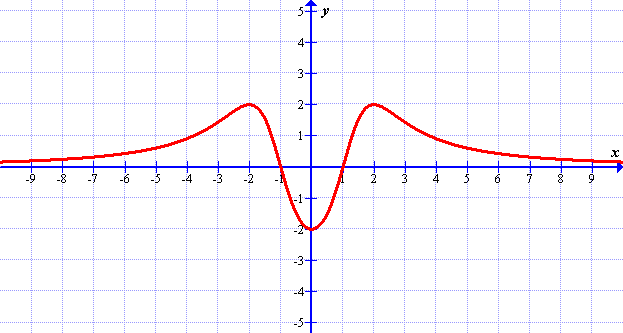
(a) \(y=x^2+1\)
(b) \(y=x^2-3\)
(c) \(y=(x-2)^2\)
Solutions: (a) Translation of 1 unit parallel to the \(y\)-axis (shift upwards 1 unit); (b) translation of −3 units parallel to the \(y\)-axis (shift downwards 3 units); (c) translation of 2 units parallel to the \(x\)-axis (shift right 2 units)(a) \(y=f(x)-2\)
(b) \(y=f(x-3)\)
(c) \(y=f(x+2)\)
Solutions: (a) Translation of −2 units along the \(y\)-axis (shift downwards 2 units); (b) translation of 3 units along the \(x\)-axis (shift right 3 units); (c) translation of −2 units along the \(x\)-axis (shift left 2 units)(a) \(y=2\,f(x)\)
(b) \(y=3\,f(x)\)
(c) \(y=\frac{1}{2}\,f(x)\)
Solutions: (a) Dilation along the \(y\)-axis by a scale factor 2 (stretch along \(y\)-axis by 2); (b) dilation along the \(y\)-axis by a scale factor 3 (stretch along \(y\)-axis by 3); (c) dilation along the \(y\)-axis by a scale factor \(\frac{1}{2}\) (stretch along \(y\)-axis by \(\frac{1}{2}\))(a) \(y=-\,f(x)\)
(b) \(y=-2\,f(x)\)
(c) \(y=-\frac{1}{2}\,f(x)\)
Solutions: (a) Dilation along the \(y\)-axis by a scale factor −1 = reflection in the \(x\)-axis (flip upside down); (b) dilation along the \(y\)-axis by a scale factor −2 (flip upside down and stretch along \(y\)-axis by 2); (c) dilation along the \(y\)-axis by a scale factor \(-\frac{1}{2}\) (flip upside down and stretch along \(y\)-axis by \(\frac{1}{2}\))(a) \(y=2\,f(x)\)
(b) \(y=\frac{1}{2}\,f(x)\)
(c) \(y=-\,f(x)\)
(d) \(y=-2\,f(x)\)
Solutions: (a) Dilation along the \(y\)-axis by a scale factor 2; (b) dilation along the \(y\)-axis by a scale factor \(\frac{1}{2}\); (c) reflection in the \(x\)-axis; (d) dilation along the \(y\)-axis by a scale factor −2(a) \(y=f(2x)\)
(b) \(y=f(3x)\)
(c) \(y=f(\frac{x}{2})\)
Solutions: (a) Dilation along the \(x\)-axis by a scale factor \(\frac{1}{2}\) (stretch along \(x\)-axis by \(\frac{1}{2}\)); (b) dilation along the \(x\)-axis by a scale factor \(\frac{1}{3}\) (stretch along \(x\)-axis by \(\frac{1}{3}\)); (c) dilation along the \(x\)-axis by a scale factor 2 (stretch along \(x\)-axis by 2)(a) \(y=f(-x)\)
(b) \(y=f(-2x)\)
(c) \(y=f(-\frac{x}{2})\)
Solutions: (a) Dilation along the \(x\)-axis by a scale factor −1 = reflection in the \(y\)-axis (flip left-to-right); (b) dilation along the \(x\)-axis by a scale factor \(-\frac{1}{2}\) (flip left-to-right and stretch along \(x\)-axis by \(\frac{1}{2}\)); (c) dilation along the \(x\)-axis by a scale factor −2 (flip left-to-right and stretch along \(x\)-axis by 2)(a) \(y=f(2x)\)
(b) \(y=f(-x)\)
(c) \(y=f(-2x)\)
Solutions: (a) Dilation along the \(x\)-axis by a scale factor \(\frac{1}{2}\); (b) reflection in the \(y\)-axis; (c) dilation along the \(x\)-axis by a scale factor \(-\frac{1}{2}\)(a) \(y=f(x)-2\)
(b) \(y=f(x-2)\)
(c) \(y=2f(x)\)
(d) \(y=-\frac{1}{2}f(x)\)
(e) \(y=f\left(\frac{1}{2}x\right)\)

(a) \(f(g(1))\)
(b) \((f\circ g)(-2)\)
(c) \((g\circ f)(-2)\)
(d) \((g\circ f)(5)\)
Solutions: (a) \(f(g(1))=(f\circ g)(1)=10\); (b) \((f\circ g)(-2)=19\); (c) \((g\circ f)(-2)=27\); (d) \((g\circ f)(5)=258\)(a) \((f\circ g)(x)\)
(b) \((g\circ f)(x)\)
Solutions: (a) \((f\circ g)(x)=3(x^2+2)+1=3x^2+7\); (b) \((g\circ f)(x)=(3x+1)^2+2=9x^2+6x+3\)(a) \(f\circ g\)
(b) \(g\circ f\)
Solutions: (a) \((f\circ g)(x)=\frac{1}{5x-2}\); (b) \((g\circ f)(x)=5\cdot\frac{1}{x}-2\)(a) \(f\circ g\)
(b) \(g\circ f\)
Solutions: (a) \((f\circ g)(x)=\sqrt[3]{\frac{1}{x+2}}\) or \(f\circ g\!:~x\mapsto\sqrt[3]{\frac{1}{x+2}}\); (b) \((g\circ f)(x)=\frac{1}{\sqrt[3]{x}+2}\) or \(g\circ f\!:~x\mapsto\frac{1}{\sqrt[3]{x}+2}\)(a) \((f\circ g)(x)\)
(b) \((g\circ f)(x)\)
Solutions: (a) \((f\circ g)(x)=\frac{x+3}{2x+3}\); (b) \((g\circ f)(x)=\frac{4x+3}{x}\)(a) \(f(g(x))\)
(b) \(g(f(x))\)
Solutions: (a) \((f\circ g)(x)=\frac{2x+5}{6x+13}\); (b) \((g\circ f)(x)=\frac{4x+16}{3x+11}\)(a) \(f\circ g\)
(b) \(g\circ f\)
Solutions: (a) \((f\circ g)(x)=x\); (b) \((g\circ f)(x)=x\)\(f\circ f\)
Solutions: \((f\circ f)(x)=\frac{3x+4}{2x+3}\)(a) write down \((f\circ g)(x)\),
(b) solve the equation \((f\circ g)(x)=0\)
Solutions: (a) \((f\circ g)(x)=x^2-5x+6\); (b) \(x_1=2,~ x_2=3\)(a) write down \(f(g(x))\)
(b) solve the equation \(f(g(x))=\frac{\textstyle1}{\textstyle2}\)
Solutions: (a) \((f\circ g)(x)=\frac{3x+1}{x+7}\); (b) \(x=1\)(a) write down \(f\circ g\),
(b) solve the equation \((f\circ g)(x)=h(x)\)
Solutions: (a) \((f\circ g)(x)=4x^2-8x+3\); (b) \(x_1=1,~ x_2=\frac{7}{4}\)(a) write down \((f\circ g)(x)\),
(b) prove that \((h\circ h)(x)=\frac{\textstyle 3x+5}{\textstyle x+3}\),
(c) solve the equation \((f\circ g)(x)=(h\circ h)(x)\)
Solutions: (a) \((f\circ g)(x)=\frac{3x+7}{x+1}\); (c) \(x=-2\)(a) write down and simplify the equation of \(k(x)\),
(b) using GDC draw the graph of \(y=k(x)\),
(c) find the range of \(k(x)\)
Solutions: (a) \(k(x)=\frac{1}{4}x^2+\frac{1}{2}x-\frac{7}{4}\); (c) range \(=[-2,\infty)\)(a) \(f(x)=2x+1\)
(b) \(f(x)=3x-2\)
(c) \(f(x)=\frac{1}{4}x+\frac{1}{2}\)
Solutions: (a) \(f^{-1}(x)=\frac{x-1}{2}\); (b) \(f^{-1}(x)=\frac{x+2}{3}\); (c) \(f^{-1}(x)=4x-2\)(a) \(f(x)=x^3+2\)
(b) \(f(x)=2x^3\)
(c) \(f(x)=\frac{1}{4}x^3\)
Solutions: (a) \(f^{-1}(x)=\sqrt[3]{x-2}\); (b) \(f^{-1}(x)=\sqrt[3]{\frac{x}{2}}\); (c) \(f^{-1}(x)=\sqrt[3]{4x}\)(a) \(f(x)=2^x\)
(b) \(f(x)=2^x+1\)
(c) \(f(x)=2^{x+1}\)
Solutions: (a) \(f^{-1}(x)=\log_2 x\); (b) \(f^{-1}(x)=\log_2 (x-1)\); (c) \(f^{-1}(x)=\log_2 x-1\)(a) write down the inverse function \(f^{-1}(x)\)
(b) draw graphs of \(f(x)\) and \(f^{-1}(x)\) in the same coordinate system.
Solutions: (a) \(f^{-1}(x)=x^3-3\)(a) \({\displaystyle f(x)=\frac{x+5}{3x-2}}\)
(b) \({\displaystyle f(x)=\frac{3x}{x-2}}\)
Solutions: (a) \(f^{-1}(x)=\frac{2x+5}{3x-1}\); (b) \(f^{-1}(x)=\frac{2x}{x-3}\)(a) \({\displaystyle f(x)=\frac{x-5}{x+2}}\)
(b) \({\displaystyle f(x)=\frac{1+x}{1-x}}\)
Solutions: (a) \(f^{-1}(x)=\frac{2x+5}{-x+1}\); (b) \(f^{-1}(x)=\frac{x-1}{x+1}\)(a) \({\displaystyle f(x)=\frac{x+2}{x-1}}\)
(b) \({\displaystyle f(x)=\frac{2x}{x-2}}\)
Solutions: (a) \(f^{-1}(x)=\frac{x+2}{x-1}\); (b) \(f^{-1}(x)=\frac{2x}{x-2}\) — in both cases \(f^{-1}(x)=f(x)\)(a) \(f(x^{-1})\)
(b) \(\big(f(x)\big)^{-1}\)
(c) \(f^{-1}(x)\)
Solutions: (a) \(f(x^{-1})=\frac{5x-2}{4x-3}\); (b) \(\big(f(x)\big)^{-1}=\frac{3x-4}{2x-5}\); (c) \(f^{-1}(x)=\frac{4x-5}{3x-2}\)(a) \(f^{-1}(x)\)
(b) \(g^{-1}(x)\)
(c) \((f\circ g)(x)\)
(d) \((f\circ g)^{-1}(x)\)
(e) \((g^{-1} \circ f^{-1})(x)\)
Solutions: (a) \(f^{-1}(x)=2x+5\); (b) \(g^{-1}(x)=\frac{3}{x-1}\); (c) \((f\circ g)(x)=\frac{-4x+3}{2x}\); (d,e) \((f\circ g)^{-1}(x)=(g^{-1} \circ f^{-1})(x)=\frac{3}{2x+4}\)(a) for \(x\geqslant 0\),
(b) for \(x\leqslant 0\).
Solutions: (a) \(f^{-1}(x)=\sqrt{x+3}\); (b) \(f^{-1}(x)=-\sqrt{x+3}\)